2011 CHEVROLET CORVETTE window
[x] Cancel search: windowPage 60 of 428
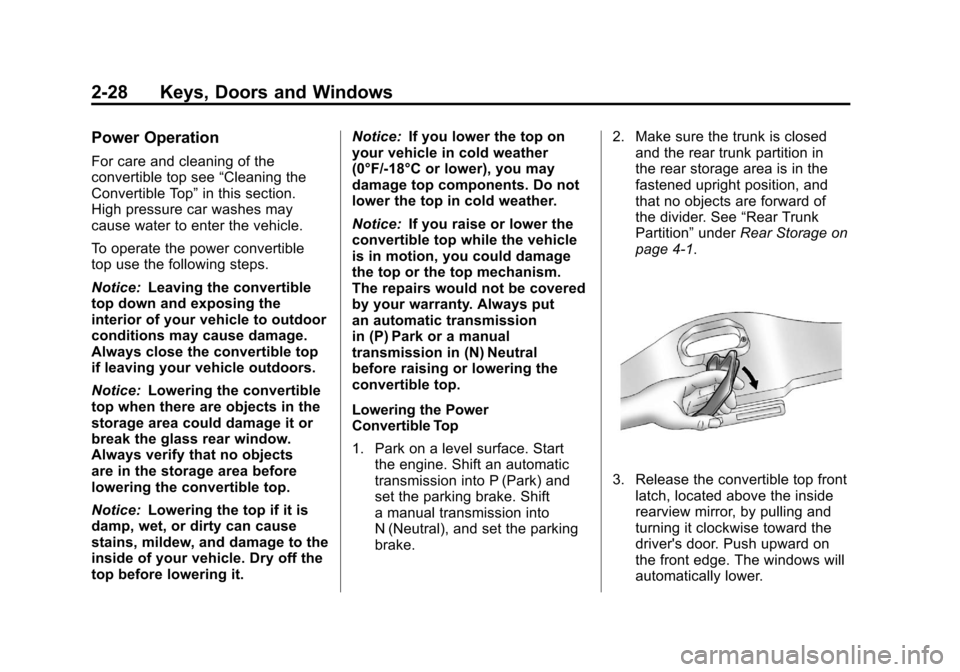
Black plate (28,1)Chevrolet Corvette Owner Manual - 2011
2-28 Keys, Doors and Windows
Power Operation
For care and cleaning of the
convertible top see“Cleaning the
Convertible Top” in this section.
High pressure car washes may
cause water to enter the vehicle.
To operate the power convertible
top use the following steps.
Notice: Leaving the convertible
top down and exposing the
interior of your vehicle to outdoor
conditions may cause damage.
Always close the convertible top
if leaving your vehicle outdoors.
Notice: Lowering the convertible
top when there are objects in the
storage area could damage it or
break the glass rear window.
Always verify that no objects
are in the storage area before
lowering the convertible top.
Notice: Lowering the top if it is
damp, wet, or dirty can cause
stains, mildew, and damage to the
inside of your vehicle. Dry off the
top before lowering it. Notice:
If you lower the top on
your vehicle in cold weather
(0°F/-18°C or lower), you may
damage top components. Do not
lower the top in cold weather.
Notice: If you raise or lower the
convertible top while the vehicle
is in motion, you could damage
the top or the top mechanism.
The repairs would not be covered
by your warranty. Always put
an automatic transmission
in (P) Park or a manual
transmission in (N) Neutral
before raising or lowering the
convertible top.
Lowering the Power
Convertible Top
1. Park on a level surface. Start the engine. Shift an automatic
transmission into P (Park) and
set the parking brake. Shift
a manual transmission into
N (Neutral), and set the parking
brake. 2. Make sure the trunk is closed
and the rear trunk partition in
the rear storage area is in the
fastened upright position, and
that no objects are forward of
the divider. See “Rear Trunk
Partition” underRear Storage on
page 4‑1.
3. Release the convertible top front latch, located above the inside
rearview mirror, by pulling and
turning it clockwise toward the
driver's door. Push upward on
the front edge. The windows will
automatically lower.
Page 61 of 428

Black plate (29,1)Chevrolet Corvette Owner Manual - 2011
Keys, Doors and Windows 2-29
4. Return the convertible top frontlatch to the closed position.
5. Push and hold the bottom of thepower convertible top button,
located to the left of the steering
wheel, on the instrument panel. The convertible top will lower into
the rear of the vehicle. A chime will
sound when the convertible top has
lowered completely. If the radio is
on the sound may be muted for a
brief time due to a new audio
system equalization being loaded.
If the convertible top is operated
multiple times, the engine should
be running to prevent drain on the
vehicle's battery. Under certain
conditions, the Driver Information
Center (DIC) may display a
message regarding the power
convertible top. See
Convertible
Top Messages on page 5‑37 for
more information. Raising the Power Convertible Top
Notice:
If you raise or lower
the convertible top while the
vehicle is in motion, you could
damage the top or the top
mechanism. The repairs would
not be covered by your warranty.
Always put an automatic
transmission in (P) Park
or a manual transmission
in (N) Neutral before raising or
lowering the convertible top.
1. Park on a level surface. Start the engine. Shift an automatic
transmission into P (Park) and
set the parking brake. Shift
a manual transmission into
N (Neutral) and set the parking
brake.
2. Make sure the trunk lid is closed and the rear trunk partition in
the rear storage area is in the
fastened upright position, and
that no objects are forward of
the divider. See “Rear Trunk
Partition” underRear Storage on
page 4‑1.
Page 62 of 428
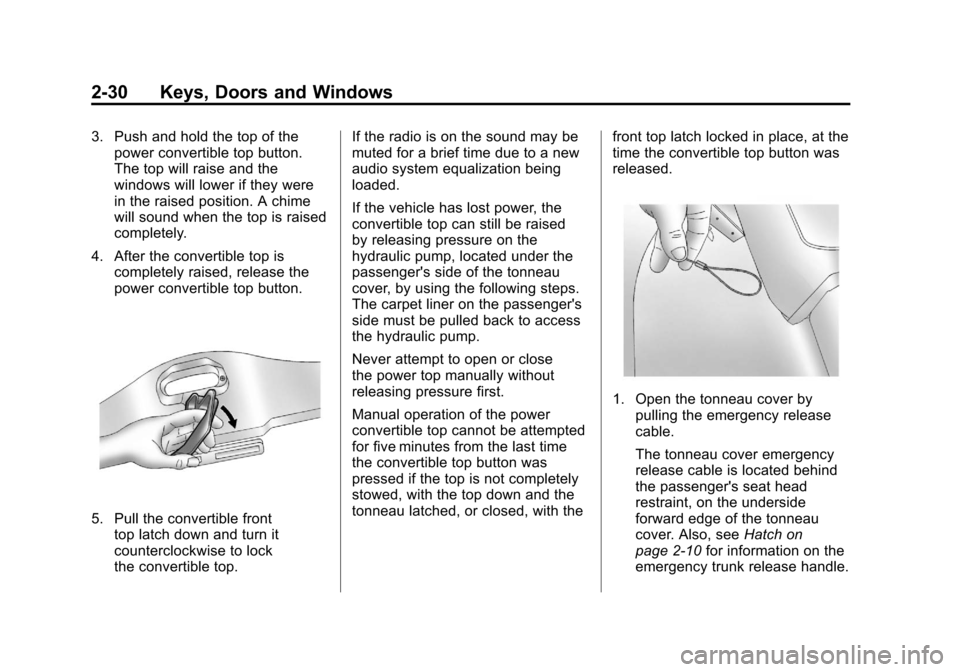
Black plate (30,1)Chevrolet Corvette Owner Manual - 2011
2-30 Keys, Doors and Windows
3. Push and hold the top of thepower convertible top button.
The top will raise and the
windows will lower if they were
in the raised position. A chime
will sound when the top is raised
completely.
4. After the convertible top is completely raised, release the
power convertible top button.
5. Pull the convertible fronttop latch down and turn it
counterclockwise to lock
the convertible top. If the radio is on the sound may be
muted for a brief time due to a new
audio system equalization being
loaded.
If the vehicle has lost power, the
convertible top can still be raised
by releasing pressure on the
hydraulic pump, located under the
passenger's side of the tonneau
cover, by using the following steps.
The carpet liner on the passenger's
side must be pulled back to access
the hydraulic pump.
Never attempt to open or close
the power top manually without
releasing pressure first.
Manual operation of the power
convertible top cannot be attempted
for five minutes from the last time
the convertible top button was
pressed if the top is not completely
stowed, with the top down and the
tonneau latched, or closed, with the
front top latch locked in place, at the
time the convertible top button was
released.
1. Open the tonneau cover by
pulling the emergency release
cable.
The tonneau cover emergency
release cable is located behind
the passenger's seat head
restraint, on the underside
forward edge of the tonneau
cover. Also, see Hatch on
page 2‑10 for information on the
emergency trunk release handle.
Page 63 of 428
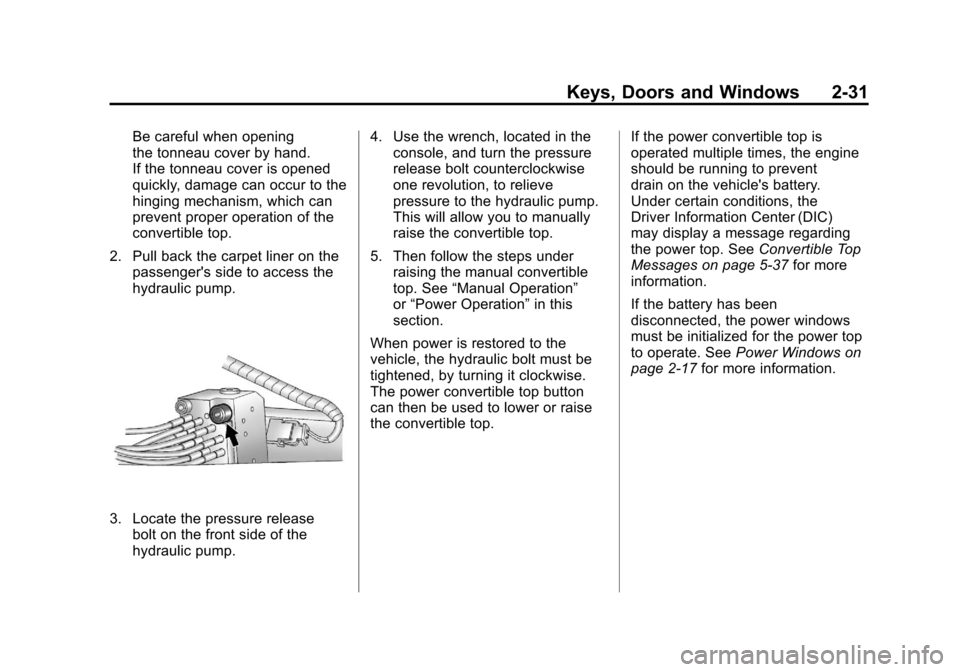
Black plate (31,1)Chevrolet Corvette Owner Manual - 2011
Keys, Doors and Windows 2-31
Be careful when opening
the tonneau cover by hand.
If the tonneau cover is opened
quickly, damage can occur to the
hinging mechanism, which can
prevent proper operation of the
convertible top.
2. Pull back the carpet liner on the passenger's side to access the
hydraulic pump.
3. Locate the pressure releasebolt on the front side of the
hydraulic pump. 4. Use the wrench, located in the
console, and turn the pressure
release bolt counterclockwise
one revolution, to relieve
pressure to the hydraulic pump.
This will allow you to manually
raise the convertible top.
5. Then follow the steps under raising the manual convertible
top. See “Manual Operation”
or “Power Operation” in this
section.
When power is restored to the
vehicle, the hydraulic bolt must be
tightened, by turning it clockwise.
The power convertible top button
can then be used to lower or raise
the convertible top. If the power convertible top is
operated multiple times, the engine
should be running to prevent
drain on the vehicle's battery.
Under certain conditions, the
Driver Information Center (DIC)
may display a message regarding
the power top. See
Convertible Top
Messages on page 5‑37 for more
information.
If the battery has been
disconnected, the power windows
must be initialized for the power top
to operate. See Power Windows on
page 2‑17 for more information.
Page 64 of 428
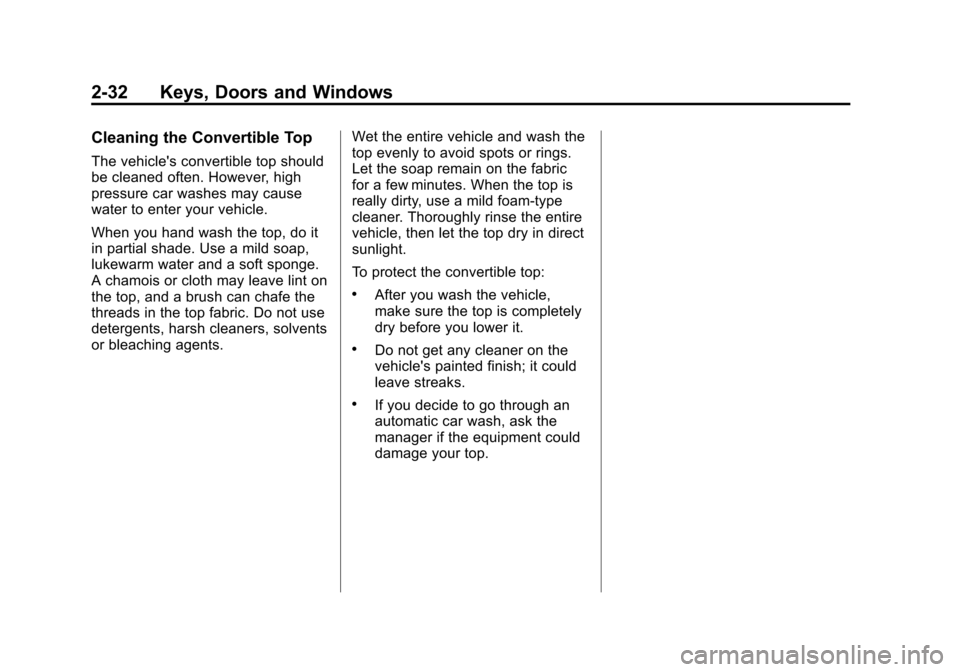
Black plate (32,1)Chevrolet Corvette Owner Manual - 2011
2-32 Keys, Doors and Windows
Cleaning the Convertible Top
The vehicle's convertible top should
be cleaned often. However, high
pressure car washes may cause
water to enter your vehicle.
When you hand wash the top, do it
in partial shade. Use a mild soap,
lukewarm water and a soft sponge.
A chamois or cloth may leave lint on
the top, and a brush can chafe the
threads in the top fabric. Do not use
detergents, harsh cleaners, solvents
or bleaching agents.Wet the entire vehicle and wash the
top evenly to avoid spots or rings.
Let the soap remain on the fabric
for a few minutes. When the top is
really dirty, use a mild foam-type
cleaner. Thoroughly rinse the entire
vehicle, then let the top dry in direct
sunlight.
To protect the convertible top:
.After you wash the vehicle,
make sure the top is completely
dry before you lower it.
.Do not get any cleaner on the
vehicle's painted finish; it could
leave streaks.
.If you decide to go through an
automatic car wash, ask the
manager if the equipment could
damage your top.
Page 87 of 428
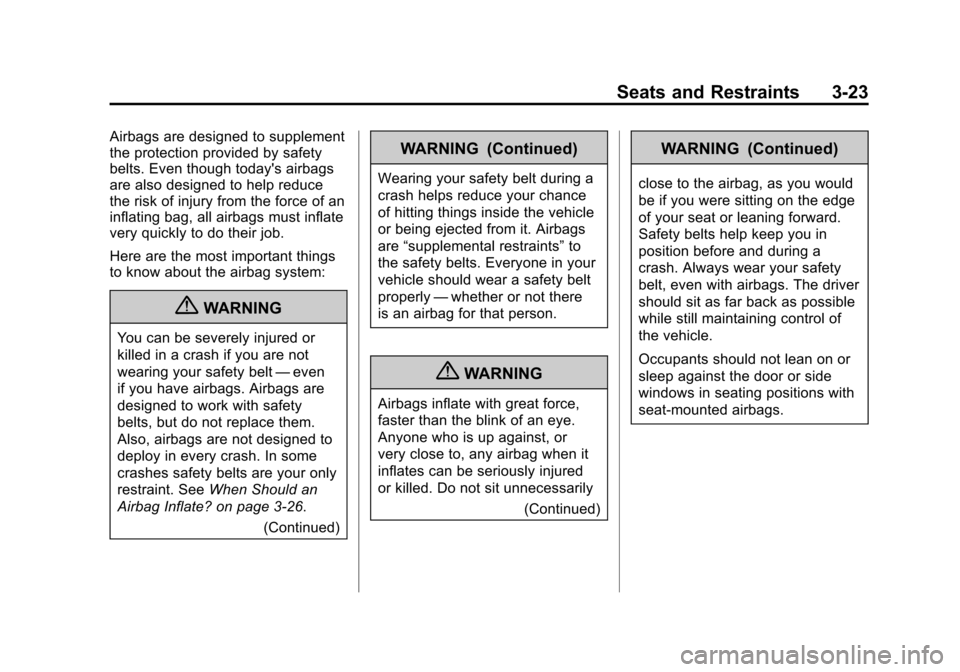
Black plate (23,1)Chevrolet Corvette Owner Manual - 2011
Seats and Restraints 3-23
Airbags are designed to supplement
the protection provided by safety
belts. Even though today's airbags
are also designed to help reduce
the risk of injury from the force of an
inflating bag, all airbags must inflate
very quickly to do their job.
Here are the most important things
to know about the airbag system:
{WARNING
You can be severely injured or
killed in a crash if you are not
wearing your safety belt—even
if you have airbags. Airbags are
designed to work with safety
belts, but do not replace them.
Also, airbags are not designed to
deploy in every crash. In some
crashes safety belts are your only
restraint. See When Should an
Airbag Inflate? on page 3‑26.
(Continued)
WARNING (Continued)
Wearing your safety belt during a
crash helps reduce your chance
of hitting things inside the vehicle
or being ejected from it. Airbags
are“supplemental restraints” to
the safety belts. Everyone in your
vehicle should wear a safety belt
properly —whether or not there
is an airbag for that person.
{WARNING
Airbags inflate with great force,
faster than the blink of an eye.
Anyone who is up against, or
very close to, any airbag when it
inflates can be seriously injured
or killed. Do not sit unnecessarily
(Continued)
WARNING (Continued)
close to the airbag, as you would
be if you were sitting on the edge
of your seat or leaning forward.
Safety belts help keep you in
position before and during a
crash. Always wear your safety
belt, even with airbags. The driver
should sit as far back as possible
while still maintaining control of
the vehicle.
Occupants should not lean on or
sleep against the door or side
windows in seating positions with
seat-mounted airbags.
Page 92 of 428
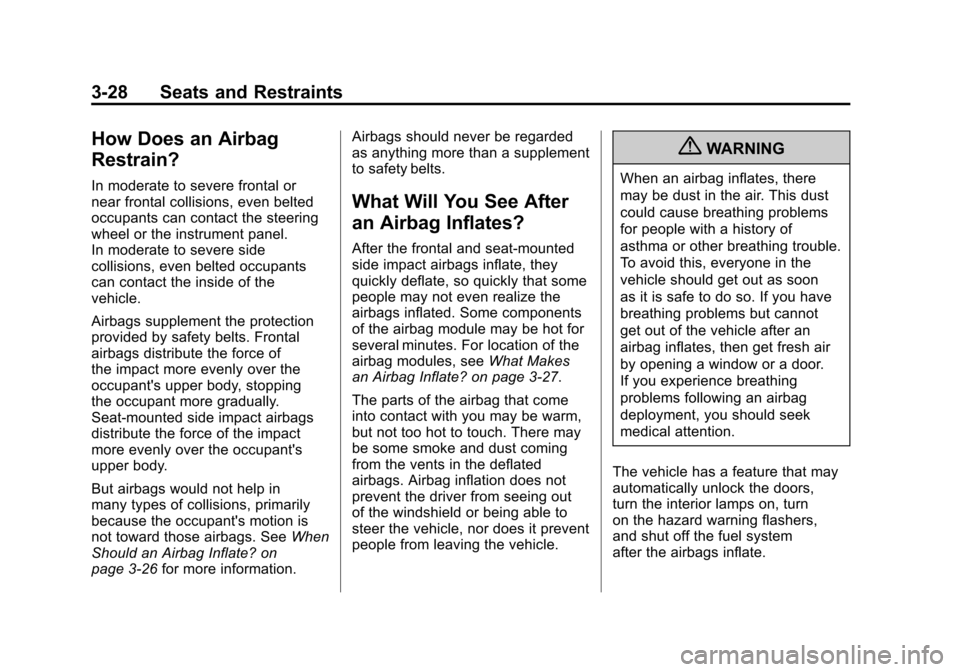
Black plate (28,1)Chevrolet Corvette Owner Manual - 2011
3-28 Seats and Restraints
How Does an Airbag
Restrain?
In moderate to severe frontal or
near frontal collisions, even belted
occupants can contact the steering
wheel or the instrument panel.
In moderate to severe side
collisions, even belted occupants
can contact the inside of the
vehicle.
Airbags supplement the protection
provided by safety belts. Frontal
airbags distribute the force of
the impact more evenly over the
occupant's upper body, stopping
the occupant more gradually.
Seat-mounted side impact airbags
distribute the force of the impact
more evenly over the occupant's
upper body.
But airbags would not help in
many types of collisions, primarily
because the occupant's motion is
not toward those airbags. SeeWhen
Should an Airbag Inflate? on
page 3‑26 for more information. Airbags should never be regarded
as anything more than a supplement
to safety belts.
What Will You See After
an Airbag Inflates?
After the frontal and seat-mounted
side impact airbags inflate, they
quickly deflate, so quickly that some
people may not even realize the
airbags inflated. Some components
of the airbag module may be hot for
several minutes. For location of the
airbag modules, see
What Makes
an Airbag Inflate? on page 3‑27.
The parts of the airbag that come
into contact with you may be warm,
but not too hot to touch. There may
be some smoke and dust coming
from the vents in the deflated
airbags. Airbag inflation does not
prevent the driver from seeing out
of the windshield or being able to
steer the vehicle, nor does it prevent
people from leaving the vehicle.
{WARNING
When an airbag inflates, there
may be dust in the air. This dust
could cause breathing problems
for people with a history of
asthma or other breathing trouble.
To avoid this, everyone in the
vehicle should get out as soon
as it is safe to do so. If you have
breathing problems but cannot
get out of the vehicle after an
airbag inflates, then get fresh air
by opening a window or a door.
If you experience breathing
problems following an airbag
deployment, you should seek
medical attention.
The vehicle has a feature that may
automatically unlock the doors,
turn the interior lamps on, turn
on the hazard warning flashers,
and shut off the fuel system
after the airbags inflate.
Page 106 of 428
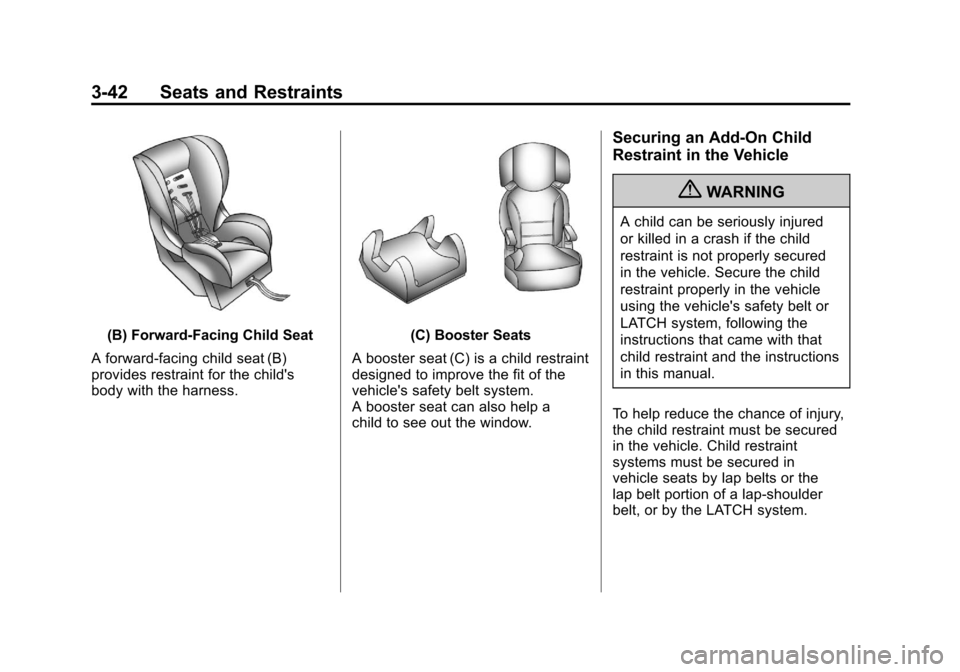
Black plate (42,1)Chevrolet Corvette Owner Manual - 2011
3-42 Seats and Restraints
(B) Forward-Facing Child Seat
A forward-facing child seat (B)
provides restraint for the child's
body with the harness.(C) Booster Seats
A booster seat (C) is a child restraint
designed to improve the fit of the
vehicle's safety belt system.
A booster seat can also help a
child to see out the window.
Securing an Add-On Child
Restraint in the Vehicle
{WARNING
A child can be seriously injured
or killed in a crash if the child
restraint is not properly secured
in the vehicle. Secure the child
restraint properly in the vehicle
using the vehicle's safety belt or
LATCH system, following the
instructions that came with that
child restraint and the instructions
in this manual.
To help reduce the chance of injury,
the child restraint must be secured
in the vehicle. Child restraint
systems must be secured in
vehicle seats by lap belts or the
lap belt portion of a lap-shoulder
belt, or by the LATCH system.